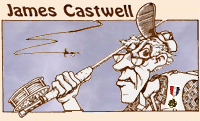|
August 24th, 1998
REPLY
" JC, Nice article, but I have to really wonder how much time
you spent studying how the trout knows if the angler is upstream or downstream
from its position???? Or, at a 45 degree angle or 20 degree or 33 and 1/2 degree.
Could you please do another article and explain this??? Tight Lines Scud."
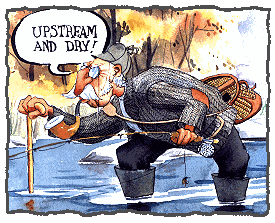
Dear Mr. Scud,
Thank you for the response to my column of last week. You are
most correct in your inquiry. I did not in any way spell out any differences
in the attitude of trout taking, or, attempting to take dry flies from a downstream,
or a upstream position. For that I am remise, please forgive me.
As to your first inquiry; the amount of time? Is this
in reference to minutes, hours, days, weeks, months, or years? The
answer, as best I can calculate, is about twenty-five years. Studying,
taking approximately ten-thousand photographs, doing research for
other authors, collecting and raising insects, and a lot more very
interesting investigation.
You will find some pictures here to support
my claims. Please review them carefully as they will to a degree
answer some of your questions.
Original research was commenced many
years ago... Perhaps decades. The methods used were many:
I used photographs, on-site observation, slant-tank observation
and photographs, and lasers. I have not found it desirable to
publish these as they would take the fly fisher too far too fast.
Do I have all the answers; I don't even know all the questions.
The event of fly fishing is a journey, not a destination. However,
the results of my research were always the same. The trout spot
the food, tilt to inspect it; rise to follow, take, or, refuse.
But, about the downstream or upstream thing...
Suppose you cast and present a good drift
downstream. The trout watches the fly come at him and onto
the 'window.' He 'keys' onto the pattern at the edge of his 'window.'
He tilts up, follows and attempts to 'take.' What happens when he
does so? His mouth opens, his gills flare, and water drops through
them. He may turn a bit on the take, or, may simply tilt back down.
He basically 'takes a big drink.' Whatever happens to be in 'that
drink' falls into his mouth.
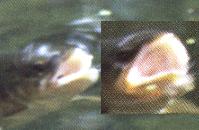
From:Ring of the Rise, Vincent C. Marinaro
If the fly is attached to a leader and is coming
toward the fish from upstream, when he opens his mouth there is a
resistance from the leader and the fly does not drop as far into his
mouth as if it were not attached to anything. This is in direct proportion
also to the size of the mouth of the fish. The larger his mouth the greater
the 'drink,' and the farther a fly needs to drop to be engaged. The result
is smaller fish will be more easily hooked than larger ones. Also, the hook
will most likely be engaged in the front of the mouth, rather than the desired
corner.
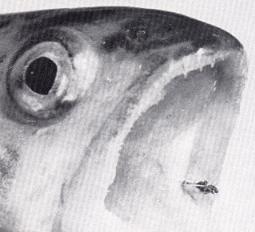
"The tiny size #24 hooks can be very successfully
used even with big fish. The only really good hold is in the
tough tissue of the corner of the jaw.The fisherman cannot
always have a choice, but if he can, he should try to draw the
hook from a position behind the fish. Drawing the hook across the
bony sides or front of the jaws usually remits the hook to escape and the
fish, too!"
From:Ring of the Rise, Vincent C. Marinaro
However, if the fly is presented from the
downstream area to the upstream fish, it is
more likely to 'fall' into the fishes mouth when he opens it, due
to the change of direction of drag (or, rather, the lack thereof).
These are of course generalities and there will be many examples
of trout being hooked solidly in the corner of the mouth on a
downstream presentation, and fish missed when presented from
below. The purpose of this is to try to give you an idea of the
success ratio between the two presentations.
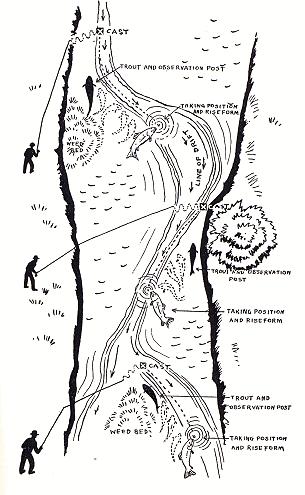
There is, of course, the obvious advantage
to the upstream presentation. When a fish is engaged he is upstream
from you. The resulting fight (or, if you will, play) happens above you
and landing is more a matter of letting the fish come to you from an
upstream direction, rather than attempting to winch him up to you,
run downstream after him, or have someone else do your landing
and netting for you.
The choices are all academic and we each
have our own preferences and rewards from our recreation. As
for myself, I much prefer to use a dry fly, casting from the
downstream area, figuring out the glides, seams and subtle
currents. This is one of the fascinating elements of fly
fishing for me. (Stream map at left from: A Modern Dry
Fly Code, Vincent C. Marinaro.)~JC
P.S. Mr.Scud is not only known to me, he is
a fishing companion, a fine host on this web site, and a valued
gentleman friend. Hope this helps to clear up your questions.
~JC
Till next week, remember ... |
